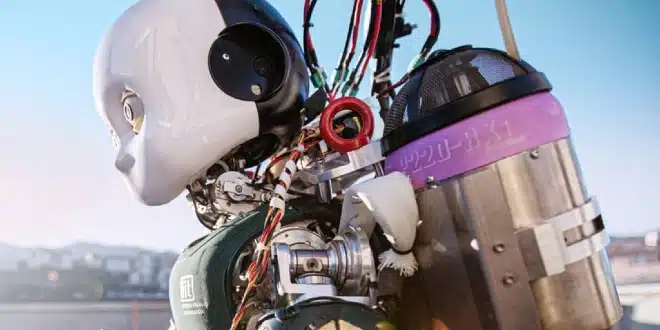A research team in Italy has accomplished a pioneering advancement in robotics by successfully testing the world’s first jet-powered flying humanoid robot. The machine, named iRonCub3, lifted approximately half a meter off the ground during a controlled test while maintaining complete flight stability. The findings were presented in the journal Nature Communications Engineering, marking a significant step toward future humanoid systems capable of flight in real-world conditions.
Developed over two years by the Italian Institute of Technology (IIT), the project aimed to design a humanoid robot capable of operating in environments that demand both walking and aerial mobility. The iRonCub3 prototype was engineered with a focus on precise flight dynamics, made possible through intensive aerodynamics modeling and the integration of high-performance control systems. Researchers have emphasized that this achievement represents a crucial shift from conventional humanoid robotics toward machines capable of dynamic environmental adaptation.
Integration of Flight and Humanoid Functionality
To develop iRonCub3, engineers from IIT’s Artificial and Mechanical Intelligence Lab collaborated with experts in aerodynamics and machine learning. Key contributions came from the Polytechnic of Milan, where aerodynamic testing took place in specialized wind tunnels, and Stanford University, where deep learning models were built to simulate and refine the robot’s airflow behavior in real time. These joint efforts enabled the robot to achieve controlled hovering and maneuverability through advanced flight controls and real-time reaction to atmospheric changes.
The iRonCub3 robot is based on the latest iteration of the iCub humanoid platform, referred to as iCub3. The new version features substantial structural upgrades, including a titanium-reinforced spine and thermal shielding to withstand extreme conditions. Its four jet turbines—two on its arms and two on a jetpack unit—are capable of generating the thrust necessary for vertical lift and aerial stabilization. Emissions from the turbines reach temperatures nearing 700 degrees Celsius, and the exhaust velocity approaches sonic speeds, posing significant challenges in both safety and precision control.
With a total weight of about 70 kilograms, iRonCub3 is designed not only to take off and land vertically but also to endure external disturbances such as wind while maintaining flight orientation. Researchers highlighted the complexity of controlling both the slow movements of the robot’s mechanical joints and the rapid adjustments needed for jet-powered flight, a balance that required precise engineering and thorough testing.
The primary goal of the iRonCub3 initiative is to create autonomous machines that can operate in hazardous or unstructured environments where traditional robots or humans may not be effective. Potential use cases for flying humanoid robots include search-and-rescue operations, disaster zone assessment, and industrial maintenance in elevated or inaccessible locations.


